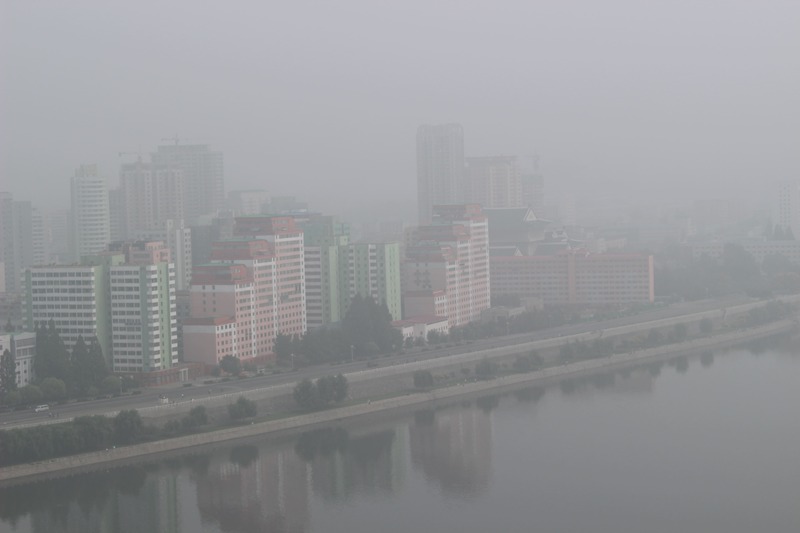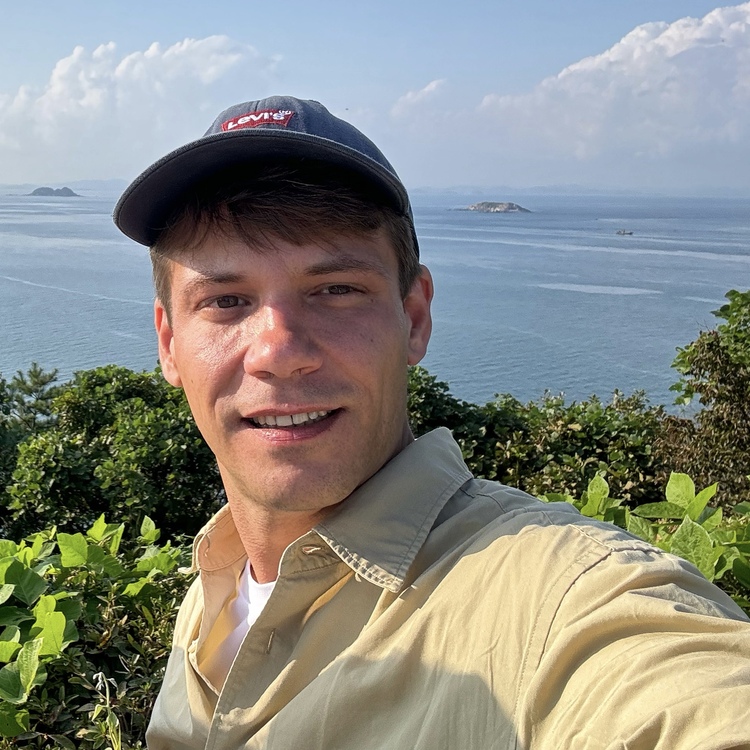My first morning in Pyongyang? I never heard the early morning broadcast of 'Where are you, dear General?' on the city's loudspeakers.
Tour leader Greg recalls his first visit to North Korea.
See here for Part 1.
My First Morning in Pyongyang
My theory is that one should focus on sleeping and not eavesdropping when one sleeps.
Hence I never heard the early morning broadcast of Where are you, dear General? on the city's loudspeakers.
Neither did I on my first morning.
After I woke up I opened the curtains and turned on the TV. Our room faced the city and had a hazy view of the Taedong River.
Anyone who has been to Pyongyang knows that there is this special morning haze in Pyongyang almost every morning and it is just as much of a part of the city as the Juche Tower, the statues on Mansu Hill, the murals, and other monuments.

The unmissable Pyongyang morning haze greeting all visitors in the mornings
On the TV I tuned into Korean Central Television where a "television exercise" was on the program.
A mix of women and men wore training outfits and did gymnastics in front of Hyangsan Hotel to the tunes of Women Are Flowers. A concept not entirely alien to me, between 1976 and 1989 the Hungarian Television also screened such a program every evening.
I had just recently watched a Hungarian TV series from 1980 where the children of the family jumped up, moved the furniture away, and started to exercise when that program started to screen. It was part of life during "Goulash Communism".
Breakfast was in the International Restaurant of Yanggakdo Hotel: omelette (it's so silky, I love it), toast, and marmalade.
Just a tip: if you can't function without coffee don't get it from here, get your proper espresso from the Tea House in the lobby. It is overpriced compared to other Pyongyang prices but much better than the instant coffee for 10 RMB. And it comes with a biscuit.
Introductory Pyongyang City Tour
Pyongyang is quasi a large socialist housing estate disrupted by a few government buildings and monuments.
This is an observation, not a value judgment.
Pyongyang had to restart from the ashes in 1953 as it was bombed to the ground by the US Air Force during the Korean War.
I also know how much it meant for hundreds of thousands if not millions of Hungarians when they could finally move into their new flats in the panel buildings featuring bathrooms, central heating, and such.
I am not naive. I know that even if Pyongyang apartments have these features they are not necessarily functioning these days.
Residents have to fill up the bathtub with water because running water is only a few hours a day. Apartments on lower floors have better value as the elevators don't run. Just to give a few examples.
I also have to admit that the cityscape of Pyongyang gives me a strange Ostalgie feeling even though I was born a bit less than 2 years before state socialism collapsed in Hungary.
But it gives me the same feeling as what I see in our family photos, old pictures of Budapest, and the memories of my early childhood. When a Polish tourist was in my group she also reported about this strange phenomenon and that the trip was also a trip back to her childhood and family vacations.
And she is just a bit older than I am.
Pyongyang City Tour
We started our day at the Fountain Park near the monument on Mansu Hill.
It is surrounded by the Mansudae Art Theatre and the Mansudae Schoolchildren's Place providing a nice view of the Grand People's Study House. It is also a popular spot for wedding photos and for the elderly to sit and read the newspaper.
Next, we visited the Mansudae Grand Monument.
Here I would like to debunk a myth that is circulating all over the internet.
Some claim that a visit to the Mansudae Grand Monument is compulsory for all groups touring Pyongyang. It is not true. At least since I work for Koryo Tours. What is true, however, is that if you choose to visit you have to bow as per local customs.
Our next stop was Kim Il Sung Square where I was more interested in local life than the the painted white circles on the ground that are meant to sign where people should stand during the parades.
Here the local cool guys were cycling.
Instead of sitting on the seat of the bicycle, they chose to sit on the back cargo rack.

The local cool guys on their bikes on Kim Il Sung Square
From Kim Il Sung Square we walked to the Foreign Languages Bookshop.
Here I had my first conversation with Mr. Pak while smoking on the side of the street. From this point on I became the distributor of Western cigarettes (in this case Marlboro, I didn't know yet that Mevius and SevenStars were the local favorites but if you want to become a local favorite Japanese brand Peace is the way to go) to our guides and drivers.
During our conversation, I learned about his studies before becoming a tour guide and how long he served in the army.
Actually, I haven't met a Korean who served for 10 years.
It seems that for men from Pyongyang with university degrees, 3-5 years is the most common.
The rationale behind this is if the state invested in their studies they should use those skills to serve the country. During our conversation, Mr. Pak also pointed out a Chinese exchange student.
Our next stop was the Tower of Juche Ideology.
After admiring the view of Pyongyang from the top of the Juche Tower, Operation Washroom followed. We were taken by Mr. Pak underground just outside of the Juche Tower where there is a labyrinth of corridors way more extensive than the ground plan of the Juche Tower with university students coming and going.
I still don't know why there were so many students and what they were up to as when I inquired what was there the answer was the toilet.
Sundays in Pyongyang
Now came a real treat. A walk in Moranbong Park and on Sungri (Vicory) Street via Pyonghattan back to Kim Il Sung Square.
I never imagined that such an extensive walk would be possible on our tour.
The park is located above the city where couples and families stroll, having picnics, barbecues, and karaoke.
I also saw one or two people painting and quite a few volleyball players. After all, volleyball is the quasi-national sport of the DPRK.
Each company in North Korea has volleyball teams and arranges in-company tournaments. It is also the sport that one can see the most often in parks all over the country.

Volleyball players in the shadow of the Liberation Monument honoring the Soviet Red Army
At a small vendor, Ms. Pak treated us to an ice cream.
Old ladies were dancing at a pavilion and invited us to dance as well. Leaving the park, we passed by a metro station, and then, walking past the Children's Department Store, we arrived at Changjon Street which is part of an urban development project and where newly built high-rise buildings were erected in 2015.
We had our lunch at a basement restaurant at Kwangbok Department Store where the main dish was Pyongyang Cold Noodles a dish I have loved ever since. Our lunch was accompanied by live music and performance.
After lunch, we got some time to shop at the Department Store and use the local currency. Back then the goods on hand were primarily Chinese imports. By 2019 more and more local products appeared on the shelves. I paid like 2.5 euros for a carton of Korean cigarettes, 2 bottles of soju, local-made toothpaste, and a scone of ice cream.
Our next destination was the Native House of Kim Il Sung in Mangyongdae. It is in beautiful park-like surroundings but hard to imagine how it looked like in its original environment back in 1912. Luckily, on a later tour, I saw a painting in the National Gallery on Kim Il Sung Square that helped me to picture it better.
The Bumpy Road to Kaesong
After visiting the birthplace of Kim Il Sung, we started our nearly 3-hour-long bus journey to Kaesong on the Reunification Highway.
The road needed a fix to put it lightly and there was hardly any traffic. People were mostly walking and cycling along the road. Buses, trucks (also carrying people), and military jeeps were the most typical vehicles.
The landscape was beautiful, dominated by mountainous and rice fields in the arable areas.
Not only farmers, but also soldiers cultivated the fields, and the sight of soldiers walking along the highway was not uncommon either. I also saw goose-herding soldiers. One soldier was wearing his military cap backwards like the cool kids do with their baseball caps. For some reason, I found this sight rather refreshing.
We passed through several tunnels, and at the end of each, there was a military post dug into the ground.
I did not see villages in the classical sense.
Even in the settlements, there were multi-story apartment buildings built after 1953.
The second half of the road is divided up by military checkpoints.
At the last one before Kaesong - along the 38th parallel -, our Korean guides and the driver had to register their entry into Kaesong. This was the first sign of controlled and restricted movement even for DPRK citizens within the country.
Our accommodation in Kaesong was in the Minsok Hotel, a traditional Korean inn where guests sleep on heated floors.
Hot water was only available for one hour. Dinner was at the hotel.
According to Korean tradition, we sat on the floor around traditional low tables while eating.
The dinner was concluded with a kayagum performance.
After dinner, I went to the bar to get some drinks.
Here is where I befriended Mr. Ri, the tour guide of the other group and who was my first guide as a Tour Later a year later in October 2017.
When he learned that I was from Hungary he remarked that Hungarians were the first to break ties with the DPRK and because of this he was quite angry. I assured Mr. Ri that since I was only a few months old, I had nothing to do with this traitorous act.
Incidentally, this is where I became Mr. Ri's tobacco cigarette supplier as well.
To be continued...
